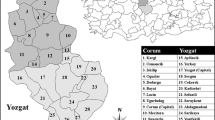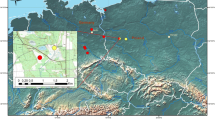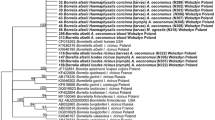Abstract
The first finding of a questing Hyalomma marginatum marginatum female tick in Germany is described. The tick was found in May 2006 on the clothing of a person who had spent the preceding day in rural surroundings in southern Germany. As the infested person had also been visiting Spain where H. m. marginatum is known to occur some weeks prior to finding the tick, it is not clear whether the tick had been imported by him as a female or by another host in a preimaginal stage and succeeded to develop to an adult in Germany. H. m. marginatum is a thermophilic tick species usually occurring in relatively dry and warm regions of southern Europe, northern Africa and some parts of Asia. It is a vector of several disease agents of human relevance including Crimean-Congo hemorrhagic fever virus. Although, by PCR examination, the female was found neither infected with this virus nor with Rickettsia aeschlimannii, another human pathogen which has been found in Spanish Hyalomma ticks, its mere finding should be taken seriously and draw further attention to the increasing problem of the import and spread of putatively tropical vectors of disease to central Europe.
Similar content being viewed by others
References
Acha PN, Szyfres B (2003) Zoonoses and communicable diseases common to man and animals, 3rd ed, vol II: Chlamydioses, Rickettsioses, and Viroses. Pan American Health Organization
Apanaskevich DA (2004) [Discrimination of subspecies in a polymorphic species Hyalomma marginatum (Acari, Ixodidae) based on adult stage]. Parazitologiya 38:20–32 [in Russian]
Beati L, Meskini M, Thiers B, Raoult D (1997) Rickettsia aeschlimannii sp. nov., a new spotted fever group rickettsia associated with Hyalomma marginatum ticks. Int J Syst Bacteriol 47:548–554
Boom R, Sol CJ, Salimans MM, Jansen CL, Wertheim-van Dillen PM, van der Noordaa J (1990) Rapid and simple method for purification of nucleic acids. J Clin Microbiol 28:495–503
Ergönül Ö (2006) Crimean-congo hemorrhagic fever. Lancet Infect Dis 6:203–214
Estrada-Peña A, Bouattour A, Camicas JL, Walker AR (2004) Ticks of domestic animals in the Mediterranean region—A guide to identification of species. University of Zaragoza, Spain
Eurosurveillance Editorial Team (2006) Increase in cases of Crimean-Congo haemorrhagic fever, Turkey, 2006. EuroSurveill 2006;11(7):E060720.2. Available from: http://www.eurosurveillance.org/ew/2006/060720.asp#2
Evstaf’ev IL (2001) [Results of the 20-year study of tick-borne encephalitis in the Crimea]. Zh Mikrobiol Epidemiol Immunobiol 2:111–114 [in Russian]
Fernández-Soto P, Encinas-Grandes A, Pérez-Sánchez R (2003) Rickettsia aeschlimannii in Spain: molecular evidence in Hyalomma marginatum and five other tick species that feed on humans. Emerg Infect Dis 9:889–890
Filipe AR, Casals J (1979) Isolation of Dhori virus from Hyalomma marginatum ticks in Portugal. Intervirology 11:124–127
Gray JS, de Vos AJ (1981) Studies on a bovine Babesia transmitted by Hyalomma marginatum rufipes. Onderstepoort J Vet Res 48:215–223
Gresikova M, Sekeyova M, Tempera G, Guglielmino S, Castro A (1978) Identification of a Sindbis virus strain isolated from Hyalomma marginatum ticks in Sicily. Acta Virol 22:231–232
Hartelt K, Oehme R, Frank H, Brockmann SO, Hassler D, Kimmig P (2004) Pathogens and symbionts in ticks: prevalence of Anaplasma phagocytophilum (Ehrlichia sp.), Wolbachia sp., Rickettsia sp., and Babesia sp. in southern Germany. Int J Med Microbiol 293 (Suppl. 37):86–92
Hillyard PD (1996) Ticks of North-West Europe. Synopses of the British Fauna (New Series) No. 52, Field Studies Council, Shrewsbury, UK
Hoogstraal H (1978) The epidemiology of tick-borne Crimean-Congo hemorrhagic fever in Asia, Europe, and Africa. J Med Entomol 15:307–417
Hoogstraal H, Kaiser MN, Traylor MA, Gaber S, Guindy E (1961) Ticks (Ixodoidea) on birds migrating from Africa to Europe and Asia. Bull Wld Hlth Org 24:197–212
Hubálek Z, Halouzka J (1996) Arthropod-borne viruses of vertebrates in Europe. Acta Scient Nat Acad Scient Bohem Brno 30:10–22
L’vov DK, Dzharkenov AF, L’vov DN, Aristova VA, Kovtunov AI, Gromashevskii VL, Vyshemirskii OI, Galkina IV, Al’khovskii SV, Samokhvalov EI, Prilipov AG, Deriabin PG, Odolevskii EI, Ibraqimov RN (2002) [Isolation of the West Nile fever virus from the great cormorant Phalacrocorax carbo, the crow Corvus corone, and Hyalomma marginatum ticks associated with them in natural and synanthropic biocenoses in the Volga delta (Astrakhan region, 2001)]. Vopr Virusol 47:7–12 [in Russian]
ProMed-mail (2007) Crimean-Congo hemorrhagic fever—Turkey. 10 Jun: 20070610.1892. http://www.promedmail.org. Accessed 31 August 2007
Purse BV, Mellor PS, Rogers DJ, Samuel AR, Mertens PPC, Baylis M (2005) Climate change and the recent emergence of bluetongue in Europe. Nat Rev Microbiol 3:171–181
Raoult D, Fournier PE, Abbou P, Caron F (2002) First documented human Rickettsia aeschlimannii infection. Emerg Infect Dis 8:748–749
Schaffner F (2006) Updated data on non-indigenous invasive mosquitoes in Europe, with special reference to France. In: Abstracts of the 15th Meeting of the European Society for Vector Ecology, University of Serres, Greece, 10–14 April 2006
Schein E, Rehbein G, Voigt WP, Zweygarth E (1981) Babesia equi (Laveran 1901) 1. Development in horses and in lymphocyte cultures. Tropenmed Parasitol 32:223–227
Sonenshine DE (1991) Biology of Ticks, Vol. 1. Oxford University Press, New York
Stern C (2005) Untersuchungen zur Rolle von Zugvögeln (Passeriformes) als Verschlepper von Zecken (Acari: Ixodidae) und Borrelia burgdorferi s.l. Diploma thesis, University of Bonn, Germany
Tonbak S, Aktas M, Altay K, Azkur AK, Kalkan A, Bolat Y, Dumanli N, Ozdarendeli A (2006) Crimean-Congo hemorrhagic fever virus: genetic analysis and tick survey in Turkey. J Clin Microbiol 44:4120–4124
Wölfel R, Paweska JT, Petersen N, Grobbelaar AA, Leman PA, Hewson R, Georges-Courbot MC, Papa A, Günther S, Drosten C (2007) Virus detection and monitoring of viral load in Crimean-Congo hemorrhagic fever patients. Emerg Infect Dis 13:1097–1100
Author information
Authors and Affiliations
Corresponding author
Rights and permissions
About this article
Cite this article
Kampen, H., Poltz, W., Hartelt, K. et al. Detection of a questing Hyalomma marginatum marginatum adult female (Acari, Ixodidae) in southern Germany. Exp Appl Acarol 43, 227–231 (2007). https://doi.org/10.1007/s10493-007-9113-y
Received:
Accepted:
Published:
Issue Date:
DOI: https://doi.org/10.1007/s10493-007-9113-y




